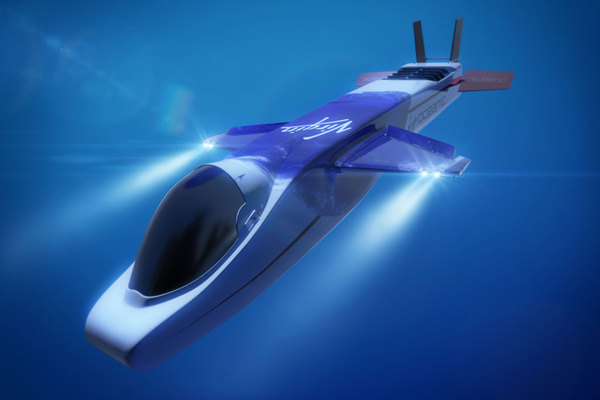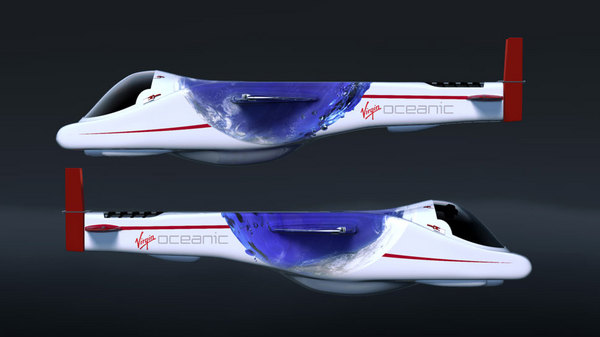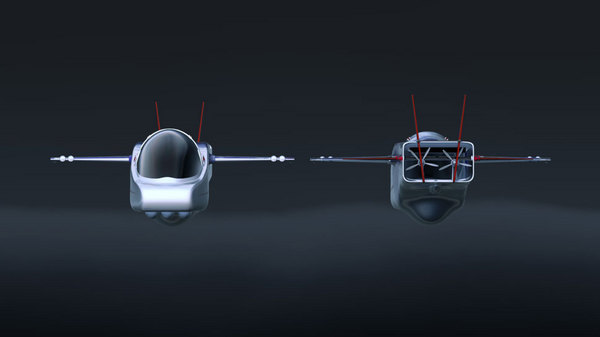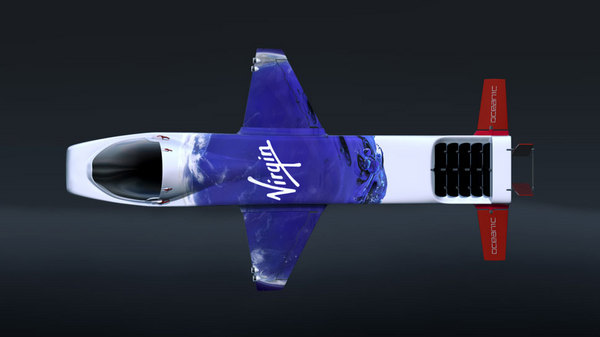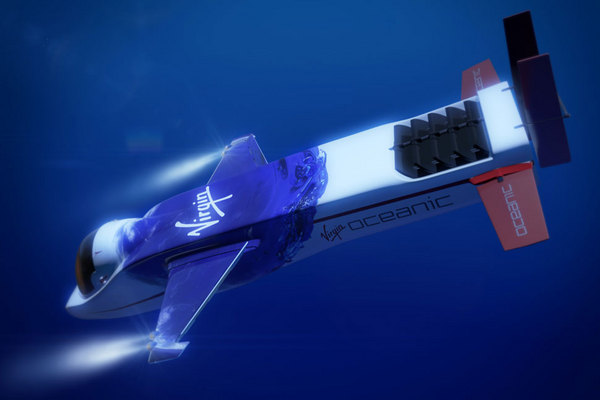Richard Branson launches Virgin Oceanic: deep-sea exploring submarines
- Xeni Jardin
- Uncategorized
- Apr 05, 2011
- Five Dives, Five Oceans, human, Mariana Trench, News, Puerto Rico, Richard Branson, Science, Sir Richard, Sir Richard Branson, Space, Two Years, Virgin Oceanic
[ Video link | image: click for large]
Today, Sir Richard Branson, American sailor, pilot and explorer Chris Welsh, and submarine designer Graham Hawkes launched Virgin Oceanic, a project to explore “the last frontiers of our own Blue Planet: the very bottom of our seas.” .
The project includes a partnership with Google: “Using their mapping technology, Google hopes to chronicle the dives as they happen and share discoveries, footage and record breaking achievements with the world.”
Full launch announcement follows, along with more artist’s conceptual images of the submarine and accompanying catamaran. Click each image for large.
“Virgin Oceanic will expand the reach of human
exploration on our planet. By promoting and utilising new
technology Virgin Oceanic will aid human kind’s ability to
explore our Oceans, assist science in understanding our eco
system and raise awareness of the challenges facing our
Oceans.” Sir Richard Branson April 2011
Tuesday 5 April, Newport Beach,
CA:
Sir Richard Branson and explorer Chris
Welsh today announced plans to take a solo piloted submarine to
the deepest points in each of the world’s five oceans – the
first time such a feat has ever been attempted.
More men have walked on the moon than have
explored the depths of our planet – many more men. Virgin
Oceanic will see the world’s only submarine capable of taking a
human being to such extreme depths make five dives over a
two-year period, set up to 30 Guinness World Records and, by
working with leading scientific institutions, open the eyes of
the world to what lies in vast areas of the oceans for the
first time in history. The Virgin Oceanic Submarine and her
pilots will travel deeper and explore further than any one in
history.
Each dive will be piloted by different
commanders with Chris Welsh diving to the Mariana Trench
(36,201ft) with Sir Richard as back up pilot, and Sir Richard
piloting to the Puerto Rico Trench (28,232ft) – the deepest
trench in the Atlantic, which has never been explored before –
with Chris Welsh acting as back up. The Virgin Oceanic
sub has the ability to ‘fly’ underwater for 10km at depth on
each of the five dives and to fully explore this unknown
environment.
Five Dives,
Five Oceans, Two Years, One Epic
Adventure
Mariana Trench
Pacific Ocean
11,033m 36,201ft
Puerto Rico
Trench
Atlantic Ocean
8,605m 28,232ft
Diamantina Trench
Indian Ocean
8,047m 26,401ft
South Sandwich Trench Southern Ocean
7,235m 23,737ft
Molloy
Deep
Arctic Ocean
5,608m
18,399ft
The National Oceanic and
Atmospheric Administration believe that the deepest point of
the Mariana Trench is 36,201ft – a depth not yet reached by
humankind. Some experts believe that it will be impossible to
reach a depth much below the current record of 35,911ft (set by
a submersible that didn’t have the capability to manoeuvre or
explore) because of millions of year’s worth of biological
‘soup’ at the bottom of the trench. They may well be
correct but we simply don’t know – with Virgin Oceanic’s
submarine’s capability to explore at the bottom of the trench
we aim to find out and, if possible, go deeper. The
Puerto Rican trench is the deepest point in the Atlantic and no
one has attempted to explore it before now.
The
Virgin Oceanic submarine represents a transformational
technological advance in submarine economics and performance.
The submarine provides the currently unequalled capability to
take humans to any depth in the oceans and to truly explore. It
utilises the latest in composite technology and a completely
unique flying wing to literally fly within the Ocean
environment; creatures living here such as dolphins, whales and
rays have shown us this winged approach is the best and most
elegant way to range the seas. The submarine is many times less
expensive to manufacture and operate than any of its less
capable counterparts and is in harmony with its environment.
The submarine was originally commissioned by Sir
Richard’s close friend and fellow adventurer Steve Fossett who
had intended to complete the first solo dive to the depths of
the Mariana Trench. Sir Richard intends to finish what his
friend started and then go on to help explore and unlock the
wonders of the Oceans still unknown to humankind or
science.
Sir Richard Branson on the launch of
Virgin Oceanic: “What if I were to tell you about a
planet, inhabited by ‘intelligent’ beings that had, in the 21st
Century, physically explored 0% of its deepest points and
mapped only 3% of its oceans by unmanned craft, when 70% of
that planet’s surface was made up of water. Then I tried
to convince you that only 10% of the life forms inhabiting that
unknown world, are known to those on the surface – you’d think
I’d fallen asleep watching the latest sci-fi blockbuster!
Then you discover that planet is Earth…
With space long ago reached by man, and commercial spaceflight
tantalisingly close, the last great challenge for humans is to
reach and explore the depths of our planet’s oceans. The
submarine will travel to the deepest trenches in our oceans and
will allow its pilot not only to reach these depths but to
explore for 10 kilometres on each of the dives.
Virgin Oceanic is working with some of the most eminent
scientific institutions in the world to collate data and
catalogue life forms that will never have been seen before by
human eyes and are unknown to science. The ability to go deep
and then explore has been a dream of these great Oceanic
Institutes – that dream is now close to becoming
reality.
We are also proud
to be partnering with Google. Using their mapping
technology, Google hopes to chronicle the dives as they happen
and share discoveries, footage and record breaking achievements
with the world.
We may well set a few Guinness World
Records while we’re at it – up to 30 I believe! Each dive
will be the world’s first solo dive to the bottom of the five
deepest trenches in the world. So there’s 5 just to start
with! We will discover a whole new world. A world
full of undiscovered species and for those who dream, a world
where Spanish galleons have lain unplundered for centuries!”
Chris Welsh:
Sir Richard Branson’s partner in the venture and
Virgin Oceanic’s chief pilot is Chris Welsh, an American
sailor, pilot and explorer: “The submarine is a unique design
made from 8,000 pounds of carbon fibre and titanium. The
pressure at the bottom of the deepest trench is 16,000 PSI or
over 1,000 atmospheres – the quartz dome alone is under 13
million pounds of pressure, the weight of three space shuttles.
No leak is tolerable; a leak would cut through stainless steel
or human flesh and mean certain death. The depth is beyond the
capabilities of any other craft, so rescue is impossible. It’s
like being on the dark side of the moon. Full pressure testing
is to be carried out over the coming months and should it fail
the mission will obviously have to be re-evaluated.
“Why go? Why not send a robot? Pictures of the top of Everest
or, for that matter, the Moon are all interesting – but no
substitute for actually going there! The view from the
sub is extraordinary, like a fighter pilot’s view. This gives
the ability to truly explore. The Virgin Oceanic sub is a game
changer for undersea exploration – with the ability to venture
anywhere in our Oceans, with a modest mother ship and a
fraction of the resources normally needed to explore regions
like this.”
I’ve had a personal interest in the oceans
and enough understanding of science to appreciate the chance
this gives for oceanographers everywhere to learn, examine, and
prove theories they have been working on for years. We can do
this for them. We’ve created a unique program of going to all
of the institutions and offering our capabilities for all to
share. They’ve told us what to seek out, where to go, and what
results will have the most value. The HD video alone will
add dramatically to the little knowledge of the deep that we
have. It’s exciting that the Virgin Oceanic Expedition will
make this kind of difference.”
About the Virgin
Oceanic’s Submarine:
Virgin Oceanic’s Submarine,
designed by Graham Hawkes, is the only piloted craft in
existence that has ‘full ocean depth’ capability. The one
person craft has an operating depth of 37,000ft (7 miles) and
is capable of operating for 24hrs unaided. Once fully
descended, the submarine’s hydroplanes (the equivalent of wings
for submarines) and thrusters will allow it to ‘fly’ up to 10km
over the ocean floor whilst collecting video and data,
something submersibles could only dream of.
At
these depths, each individual part of the sub must be able to
withstand enormous pressures, 1500 times that of an aeroplane,
and protect its pilot from the extreme conditions just inches
away. As Sir Richard and Chris each pilot the sub to the bottom
of our planet, they will be aware that should anything go
wrong, there is no rescue team that can reach them; whilst
backed up by a mission crew, once at depth, the pilot and craft
are alone.
Full pressure testing will be conducted
over the next three months.
The craft will
cruise at a max of 3 knots and can dive 350ft per minute, with
a dive to the bottom of the Mariana trench and back estimated
to take five hours.
Scientific
understanding:
As well as offering the chance for
human endeavour and exploration, the Virgin Oceanic Expedition
offers an unprecedented opportunity to conduct scientific
research and to expand our knowledge of the unique conditions,
ecosystems and geology that exist at the bottom of the oceans.
Virgin Oceanic will be working with a range of
internationally renowned scientists, researchers and
institutions to offer monitoring, data and sample collecting
opportunities during the five dives.
Tony Haymet who
has been Director of Scripps Institution of Oceanography, Vice
Chancellor for Marine Sciences, and Dean of the Graduate School
of Marine Sciences at University of California, San Diego,
since September 2006. Scripps will be one of VOE’s key science
advisers. Tony says: “It is high time that the ocean
community return to the exploration of the ocean depths and the
abyssal plains, the largest ecosystem on our planet.
Scripps Oceanography looks forward to working with all
the ocean community to marry our new generation of robotic
ocean explorers with exciting new emerging technologies that
will restart regular deep ocean exploration. We honor Jacques
Piccard and Don Walsh by continuing the exploration they
started at the Mariana Trench on January 23, 1960.”
Another member of the team is Dr Katrina Edwards, the director
of the Center for Dark Energy Biosphere Investigations (C-DEBI)
at the University of Southern California (USC). Dr Edwards’
work is primarily focused on geomicrobiology and microbal life;
the study of how, and what type, of life survives and thrives
in sediments and rocks at the bottom of the ocean.
Dr. Edwards commented on the opportunities Virgin Oceanic
provides: “From the scientific perspective, my view is that
this endeavour offers the opportunity to observe and
make measurements in an environment that is otherwise
not accessible to human exploration. This
expedition offers a lens into microbial and other species’
diversity at depth in our oceans, the most poorly accessible
habitat on earth.”
Further researchers and
scientific partners involved in the Virgin Oceanic Expedition
include:
Scripps Institution of Oceanography,
University of California, San Diego – Microbiologist Dr Doug
Bartlett is hunting for novel microbes and DNA present in the
deep trenches and deep sea engineer Kevin Hardy is designing
the lander vehicles that will help sample and bring back the
microbes, water and possibly other small creatures from the
depths. Monterey Bay Aquarium Research Institute (MBARI) /
University of Alaska, Moss Landing Marine Labs and University
of Hawaii – Dr Geoff Wheat, Dr Sam Hulme and Dr Patricia Fryer
respectively studying how tectonic plates interact through
examining the rocks, mud flows, gases and liquids that are
released on the floor of the trenches. Ocean Research and
Conservation Association – Senior Scientist and MacArthur
Fellow Dr Edith Widder, a specialist in bioluminescence (the
light produced by many ocean organisms) and novel ways to
quantify and observe this activity unobtrusively.
The
Future:
Virgin believes that the Oceans offer
exciting possibilities for human exploration and scientific
research. Our vision through Virgin Oceanic is to explore
the possibilities of enabling adventurers and pioneers to
participate in oceanic exploration.
If we are
successful in our mission with this innovative design of
submarine, then we will have proven that a vehicle can be built
to withstand the extreme pressures of the oceans and that it is
possible to take humans at far reduced risks to the bottom of
our Oceans. The submarine we unveil today will likely finish
its days on display in a museum here in the US but if we can
prove the design, Virgin may explore the possibility of future
missions involving other submarines that can collect samples
and operate tools or equipment to facilitate science and
research. When we have developed the ability to explore, we
will shortly afterwards require the ability to study, learn and
innovate, reacting to the lessons and the opportunities that we
discover in vast areas of our planet that we currently have no
knowledge of. This is our vision.
About Virgin
Oceanic’s partnership with Google
“Our mission
for Google Earth is to create an interactive virtual globe and
enable users to visit places they’ve never explored, including
the world’s oceans,” said John Hanke, Vice President of Product
Management at Google. “More than 70% of the planet’s surface is
made up of water, yet only 5% of the world’s ocean has been
explored. We’re excited to support Virgin Oceanic’s plans to
travel to parts of the planet where no one has gone before and
be able to share their discoveries using Google Maps and Google
Earth.”
About Virgin Oceanic:
Virgin
Oceanic was formed by the Virgin Group to act as a sponsor of
and partner on the Five Dives Expedition. Chris Welsh,
though his company Deep Sub LLC, owns and will operate the
submarine. The expedition will require various regulatory
approvals, including export licenses, which Deep Sub LLC will
obtain.
About Graham Hawkes sub designer:
Graham Hawkes, has designed and built over sixty manned
submersibles and over 350 Remote Operated Vehicles (ROVs).
Hawkes is known for his forward-thinking solutions and his
innovative use of materials and systems. His underwater
vehicles include the innovative Atmospheric Diving Suits (ADS)
and ROVs, which dominated the offshore oil industry segment in
the 1970s; the Deep Rover series for science and exploration,
most recently used by filmmaker, James Cameron in the IMAX
film, “Aliens of the Deep;” the Deep Flight series of
submersibles; and the design/build of the experimental protoype
DeepFlight Challenger, the only full ocean depth manned
vehicle. He is recognized world-wide as a pioneer in
innovating state of the art solutions for ocean access.
Key dates and timings:
Virgin Oceanic’s
first dive will be to the Mariana Trench later in 2011, and a
further four dives are scheduled over the next 24 months,
subject to receipt of all required regulatory approvals.

